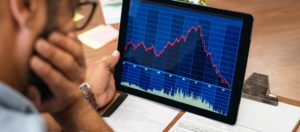We spend a lot of time worrying about interest rates, stock markets, inflation, gold, and cryptocurrencies, and how they affect our investment portfolios and personal finance. Here I explain how I think about these issues.
Are interest rates going up?
I don’t know. But the answer can’t end there. We have to make choices about our mortgages and investments, and interest rates matter. Some will express predictions confidently, but they don’t know what will happen.
I prefer to think in terms of a range. Let’s say that we think interest rates will average somewhere between 0% and 7% over the next decade. This range is wide and reflects the fact that we don’t know what will happen. Because current interest rates are still low, the range is shifted toward rate increases more than decreases. The goal now is to balance potential downside with potential upside over this range.
With mortgages, the main concern is the downside: will we be okay if mortgage rates rise to 7%? We may not be happy about this possibility, but we should be confident we could handle such a bad outcome without devastating consequences. This is why it’s risky to stretch for a house that’s too expensive.
Bonds and other fixed income investments are a good way to moderate portfolio volatility. However, long-term bonds have their own risks. If you own a 25-year bond and interest rates rise two percentage points, anyone buying your bond would want to be compensated for the 25 years of sub-par interest. This compensation is a drastically reduced bond price. For this reason, I don’t own long-term bonds. I stick to 5 years or less.
But can’t we do better? Can’t we find some useful insight into future interest rates? No, we can’t. Not even the Bank of Canada and the U.S. Federal Reserve Board know what they’ll do beyond the short term. They set interest rates in response to global events. They do their best to predict the future based on what they know today, but unexpected events, such as a war or new pandemic, can change everything.
If we get overconfident and think we have a better idea of what interest rates will be than somewhere in a wide range like 0% to 7%, all we’re doing is leaving ourselves exposed to possible outcomes we haven’t considered.
Is the stock market going to crash?
 I don’t know. With stock prices so high, it’s reasonable to assume that the odds of a stock market crash are higher than usual, and that a crash might be deeper than a typical crash. But that doesn’t mean a crash is sure to happen. The stock market could go sideways for a while. Or it could keep rising and crash later without ever getting back down as low as today’s value.
I don’t know. With stock prices so high, it’s reasonable to assume that the odds of a stock market crash are higher than usual, and that a crash might be deeper than a typical crash. But that doesn’t mean a crash is sure to happen. The stock market could go sideways for a while. Or it could keep rising and crash later without ever getting back down as low as today’s value.
People who are convinced the market is about to crash may choose to sell everything. One risk they take is that the crash they anticipate won’t come. Another risk is that even if stock prices decline, they may keep waiting for deeper declines and stay out of the market until after stock prices have recovered.
Those who blissfully ignore the possibility of a stock market crash may invest with borrowed money. The risk they take is that the market will crash and they’ll be forced to sell their depressed stocks to cover their debts.
I prefer to consider both positive and negative possibilities. I choose a path where I’ll still be okay if stocks crash, and I’ll capture some upside if stocks keep rising. If we could fast-forward 5 years, it would be easy to see whether we’d have been better off selling everything to cash or leveraging like crazy. But trying to choose between these extremes is not the best approach. I prefer to invest in a way that gives a reasonable amount of upside with the constraint that I’ll be okay if stocks disappoint.
Is inflation going to get worse or return to the low levels we’ve had in recent decades?
I don’t know. Either outcome is possible. Higher inflation is bad for long-term bonds, which is another reason why I avoid them. With short-term bonds and cash, you can always choose to invest these assets in a different way without taking as big a hit as you’d take with long-term bonds.
I choose to protect against inflation with stocks. When prices rise, businesses are getting higher prices for their goods and services. However, this protection only plays out over long periods. Over the short term, stocks can drop at the same time that inflation is high. Some people like to look at historical data and declare that stocks offer no inflation protection. These people are usually playing with mathematical tools they don’t understand very well.
All of these considerations play into the balance I’ve tried to strike with my allocation levels to stocks, bonds, and cash. I’m trying to capture some upside from good outcomes while protecting myself from disaster if I get bad outcomes.
Is gold going up?
 I don’t know. You might think my balanced approach would mean that I’d have at least a small position in gold, but I don’t. I have no interest in investing in gold. It offers no short-term protections against inflation or anything else. And over the long-term stocks have been far superior.
I don’t know. You might think my balanced approach would mean that I’d have at least a small position in gold, but I don’t. I have no interest in investing in gold. It offers no short-term protections against inflation or anything else. And over the long-term stocks have been far superior.
Gold produces nothing, and it costs money to store and guard. Gold’s price has barely appreciated in real terms over the centuries. In contrast, millions of people wake up every day to work hard at producing profits for the businesses that make up the stock market, and money invested in stocks over the centuries has grown miraculously. Continue Reading…








